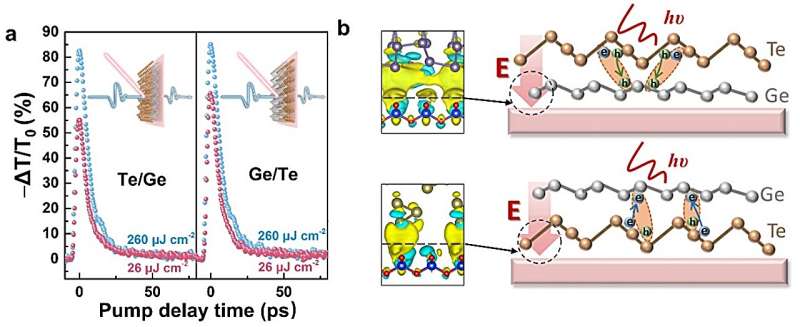This article has been reviewed according to Science X's editorial process and policies. Editors have highlighted the following attributes while ensuring the content's credibility:
fact-checked
peer-reviewed publication
trusted source
proofread
High-performance terahertz modulators induced by substrate field in Te-based all-2D heterojunctions

High-performance active terahertz (THz) modulators are of great importance for next generation communication technology. However, they currently suffer from the tradeoff between modulation depth and speed.
Two-dimensional (2D) materials with unique physical properties such as strong light-matter interactions, atomically thin profile, and fast carrier recombination, could offer an intriguing platform for investigating optoelectronic devices in fundamental physics. Therefore, it is urgent to find the favorable 2D materials that boost device performance.
The emerging mono-elemental 2D tellurium (Te) is an intriguing new option. This material, with a unique helical chain structure, has promising features, such as a layer-dependent bandgap, extraordinarily high carrier mobility, a strong optical response, and good air-stability.
In a new paper published in Light: Science & Application, a team of scientists, led by Professor Qingli Zhou from Key Laboratory of Terahertz Optoelectronics, Ministry of Education, and Beijing Advanced Innovation Center for Imaging Theory and Technology, Department of Physics, Capital Normal University, Beijing National Laboratory for Condensed Matter Physics, Institute of Physics, Chinese Academy of Sciences, China, and co-workers have developed Te-based THz modulators for successfully promoting the device performances to the optimal and applicable levels among the existing all-2D broadband modulators.
The researchers found that the Te nanofilms can achieve high modulation depth in a picosecond timescale and show an ultrasensitive response under low pump excitation. Combined with all-2D heterostructure design and substrate engineering, the parameter optimization of the device can be realized. Therefore, their fabricated heterojunction with the stacking order of Ge/Te exhibits the ultrahigh modulation depth and short-lived carrier lifetime accompanied with the low loss and broad bandwidth properties.
Further photoresponse experiments exhibit the obvious rectification effect in Ge/Te due to the interface barrier. To explore the observed significant impact of stacking order, the team calculated the direction of the substrate-induced electric field and uncovered its unusual interaction mechanism in the photoexcited carrier dynamics associated with the charge transfer and interlayer exciton recombination.
Their results could provide a more comprehensive understanding on the internal mechanism of ultrafast charge transfer and exciton dynamics in all-2D heterostructures, guide the design of heterointerfaces, and envision a new class of power-efficient, high-speed, low insertion loss, and broadband tunable THz photonic devices.
The high-performance THz modulators are centered around Te nanofilm and its heterojunctions to solve the problem of the tradeoff between modulation depth and speed. In addition, they have found that the stacking order of materials has an obvious influence on the modulation property. The calculation and analysis clarify that the effective field of the substrate engineers the band structure of the heterogeneous interface through the stacking order, and thus the optical transient behaviors can be regulated.

"We introduce 2D Te nanofilms with the unique structure as a new class of optically controlled THz modulators and demonstrate their integrated heterojunctions can successfully improve the device performances to the optimal and applicable levels among the existing all-2D broadband modulators.
"Further photoresponse measurements confirm the significant impact of the stacking order. We first clarify the direction of the substrate-induced electric field through first-principles calculations and uncover the unusual interaction mechanism in the photoexcited carrier dynamics associated with the charge transfer and interlayer exciton recombination.
"Our obtained results show the Te-based all-2D vdW heterojunctions with the substrate engineering can improve the device performances remarkably and open up a new idea for the design, optimization, and application of the optically controlled highly-efficient THz modulators," state the researchers.
"We believe that the results in this work not only are of great interest on a fundamental level but also offer guidance for future design and development of high-performance THz modulators based on functional nanomaterials," the scientists said.
More information: Pujing Zhang et al, High-performance terahertz modulators induced by substrate field in Te-based all-2D heterojunctions, Light: Science & Applications (2024). DOI: 10.1038/s41377-024-01393-6
Journal information: Light: Science & Applications
Provided by Chinese Academy of Sciences





















